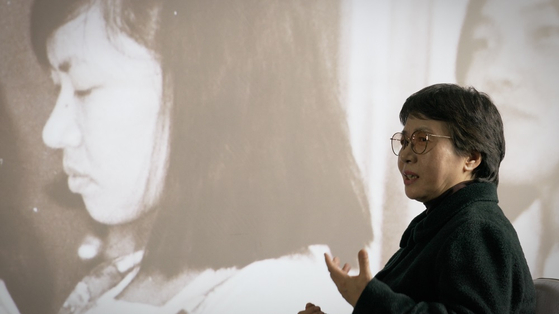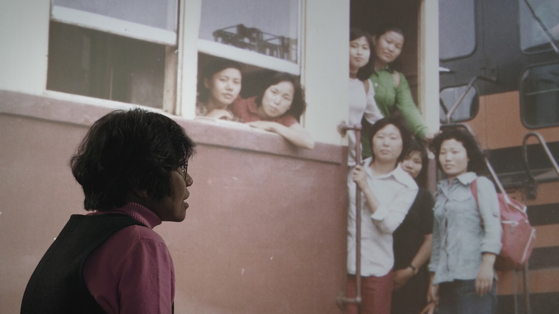'Sewing Sisters' tells story of the textile workers who fought back
![A scene from the beginning of the documentary "Sewing Sisters" [JIN JIN PICTURES]](https://koreajoongangdaily.joins.com/data/photo/2022/02/02/cc6d5e99-6fc0-42a0-b371-20ff9e62af2b.jpg)
A scene from the beginning of the documentary "Sewing Sisters" [JIN JIN PICTURES]
The phrase “miracle on the Han River” refers to the country's extraordinary economic rise spanning across half a century after the 1950-53 Korean War, before the 1997 financial crisis.
It is a term often uttered by Koreans with pride, recognizing the nation's rare feat of advancing from a developing country to a developed one. However, at the mention of the costs of these accomplishments, their pride quickly dissipates.
One iconic figure of this time was a labor activist named Chun Tae-il (1948-70), who committed suicide at the age of 22 by setting himself on fire to raise awareness about the poor working conditions of Korean factories during the 1960s.
Korea’s textile industry was one of the booming sectors which helped to shape the country’s economy. However, the industry thrived under extremely exploitative working environments as workers were oblivious to the concept of standing up for their rights or the Labor Standard Act, the basis of labor-related laws.
Chun wasn’t the only worker to fight for his rights, but he became a symbol of hope on which workers modeled themselves.
The narrative of the documentary “Sewing Sisters,” released in local theaters on Jan. 20, follows in the footsteps of women textile workers in Pyeonghwa Market (also known as Seoul Peace Market) in the 1970s. The market was a hotspot for sweat shops and the women, referred to as shida, were tasked with the final stages of garment-making such as ironing and pressing the clothes and trimming loose strands of thread.
The opening scene of the film takes place beneath a forget-me-not blue sky with three women chatting as they slowing walk toward a hill where three sewing machines stand side by side. They expertly admire clothes that have been left by the machines and and start to sew each other’s names on the material.
![From left, Im Mi-kyung, Shin Soon-ae and Lee Suk-hee start to sew each other's names on pieces of cloth. [JIN JIN PICTURES]](https://koreajoongangdaily.joins.com/data/photo/2022/02/02/53385192-3dc6-4fa6-9608-ceab55457df1.jpg)
From left, Im Mi-kyung, Shin Soon-ae and Lee Suk-hee start to sew each other's names on pieces of cloth. [JIN JIN PICTURES]
Their names are Lee Suk-hee, Shin Soon-ae and Im Mi-kyung and they were actual shida in the 70s.
One of the co-directors of this documentary, Lee Hyuk-rae, shot this scene to give the characters a chance to work in a fresh, open space.
“I wanted to shoot a scene where the women were actually working with their machines,” Lee said during a recent interview with the Korea JoongAng Daily at its office in Mapo District, western Seoul. “I realized that their working environments 40 to 50 years ago were narrow, dark and dusty spaces so as a parallel to that, I wanted them to work in a wide, bright, pleasant and open space.”
“The factories were very small, and we could hardly stand up inside,” said Im Mi-kyung after a press screening in January. “All day, we worked while bending over the machines and there was no ventilation system. So during the summer when we turned on the fans, they would stop working after two hours because they were so clogged up with dust. The dust made everything really difficult — we could hardly breathe properly and the stench of the clothing materials when we ironed them made it all the more overwhelming.”
Textile workers varied in age from those fresh out of elementary school to teens and those in their early 20s. Girls would often be whisked off to work barely after entering their teens to support their families.
After Chun’s death, a labor union was created and a labor school was formed where textile worker could receive an education. The film centers around what happened on Sept. 9, 1977 when the women protest in order to protect the labor school from martial law under then-President Park Chung Hee.
The government at the time was trying to close the school citing suspicions that it was a training school for communists.
![Co-directors Kim Jung-kyung, left, and Lee Hyuk-rae of "Sewing Sisters" pose for photos after a press screening in January. [JIN JIN PICTURES]](https://koreajoongangdaily.joins.com/data/photo/2022/02/02/06537581-070c-4bc0-b833-df6a5e51f7e6.jpg)
Co-directors Kim Jung-kyung, left, and Lee Hyuk-rae of "Sewing Sisters" pose for photos after a press screening in January. [JIN JIN PICTURES]
“As mentioned in the film, the labor school wasn’t treated and isn’t remembered as just a classroom for these employees,” Lee said. “To them it was a learning place, a playground, an environment where they could flourish. So no matter how late their work ended, even after 11 p.m., they always stopped by the classroom because it was a place even more precious then their homes, and they could not bear to have that taken away from them [...] The school was a place where they could discover what kind of person they were and realize that they could be treated decently and humanely.”
According to director Kim Jung-young, getting into contact and persuading former workers to appear in the documentary wasn’t easy because it meant they had to delve into a past they had hidden away from others. The workers involved in the Sept. 9 protest faced police brutality, jail sentences and even discrimination from work after being blacklisted.
“I had done the basic interview with our three protagonists, but I had to go out after the rest of their friends and persuade them,” Park said. “I think I went after them for about a year and a half. The rest of the interviewees were important because I structured the story based on the Sept. 9 protest and what happened that day. After interviewing the three, I also needed a glimpse from another angle — other workers’ experiences — to fit all the puzzle pieces together.”
“From an objective viewpoint, the Sept. 9 protest wasn’t a significant historical event or widely recognized,” Lee said. “It did not instigate a social movement or controversy, but to those in the labor union, it was monumental. To them, it was the biggest event that had happened [in their lives]. So I thought it was pointless to become objective about that day. What’s important was to show what was going on in these workers’ minds leading up to the protest and how they were wounded because of it. That’s why capturing their reactions was essential. Seeing how their facial expressions change and melt away thinking about their past — that would be how the audience would empathize with them [...] Since this film talks about the past, we wanted to show related papers and photographs but we didn’t want to put them all chronologically and show them in order. I wanted to capture the interviewee’s responses as they were examining or reading out [the memories], which is why our main interview format became one where two people were sitting across from each other in front of a projector screen.”


![The interviewees discuss what happened leading up to the Sept. 9 protest with a backdrop of photographs and letters they have kept. [JIN JIN PICTURES]](https://koreajoongangdaily.joins.com/data/photo/2022/02/02/f85b1589-97f0-4026-8a6e-5adfbc832e22.jpg)
The interviewees discuss what happened leading up to the Sept. 9 protest with a backdrop of photographs and letters they have kept. [JIN JIN PICTURES]
When asked what gave them courage to take a stance, the women in the interviews shrug their shoulders and say that it was the vigor from their youth or their ignorance of reality. Lee has a different perspective.
“The film was introduced overseas once at the London Korean Film Festival and there was one review that struck me,” he said. “It said, this film ‘charts their [the women’s] struggle to win the concession of basic health and safety in the workplace and the right to sensible shift patterns, days off and decent compensation — the very basics of what an employee today might expect. This wasn’t all about marches and stand-offs and noisy protests. It began with something much simpler, as those interviewed in the film explain: a growing recognition, in response to a new philosophy whispered through their ranks, that they were worth something and deserved to be treated decently.’
“I tread carefully to not to romanticize what these women went through. There is a scene where Im says [in the interview] that she decided to become the next Chun Tae-il [during the protest]. But I didn’t want people to think ‘isn’t it admirable that a 14-year-old girl says that she wants to become the next Chun Tae-il?’ That should never happen again [...] In everyone’s mind, there was a Chun Tae-il living inside them and they were determined that no other sacrifices such as his life should be made. I think that’s what gave them courage.”
Lee hopes that after participating in this documentary the women no longer feel their past should be hidden.
“I don’t think this is a story that they should feel ashamed about or hide from others,” he said. “It’s a period in which they shone the brightest — they were young, spirited and beautiful. I hoped that the interviewees could realize that through this process. That’s what this entire shoot was centered around — even though it talks about a painful part of their past, they get to re-do all the activities they did in the school. Just as they did 40 years ago, they talk, they write, they listen to each other’s writings, they dance and sing together. As they relive the 1970s, they can finally face their past and realize that they shouldn’t be ashamed about it — they were beautiful and they shone.”
BY LEE JAE-LIM [lee.jaelim@joongang.co.kr]










with the Korea JoongAng Daily
To write comments, please log in to one of the accounts.
Standards Board Policy (0/250자)